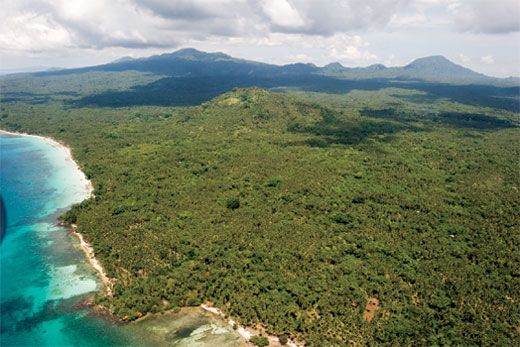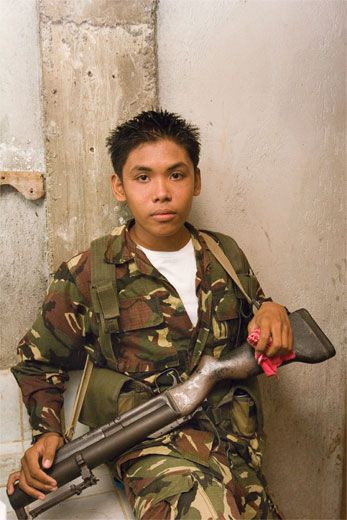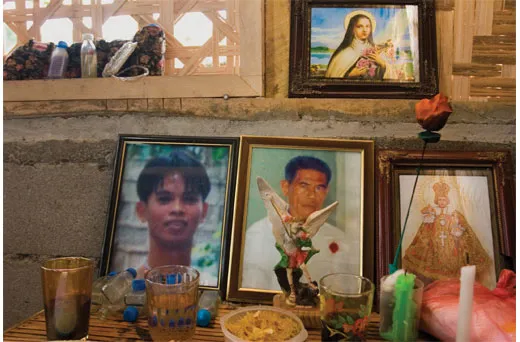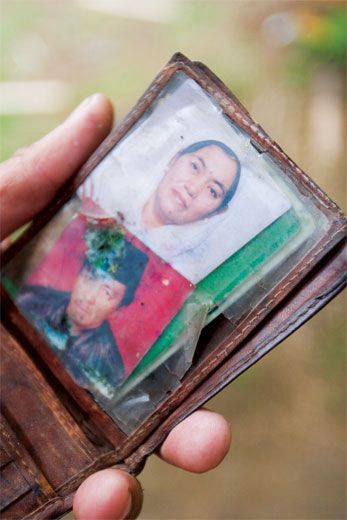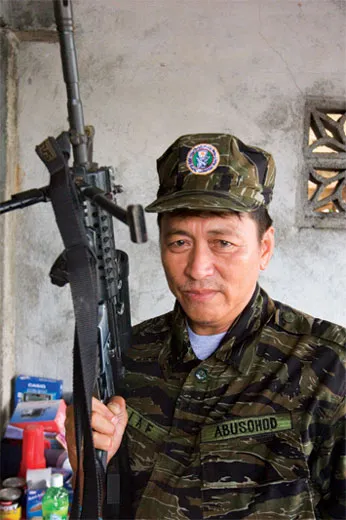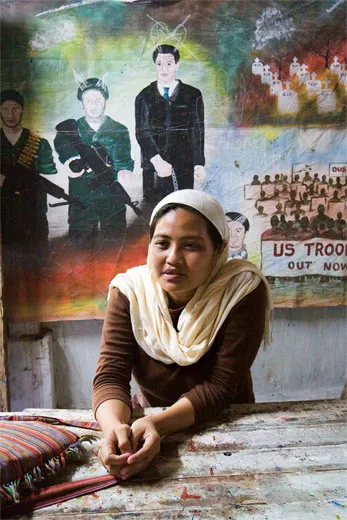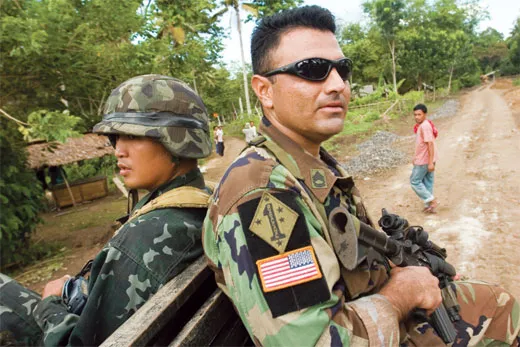Waging Peace in the Philippines
With innovative tactics, U.S. forces make headway in the “war on terror”
"They'll slit your throat on Jolo," people told Col. Jim Linder, head of a U.S. military task force in the Philippines. He recalled the prediction as we buzzed toward Jolo Island in a helicopter. Linder, a 45-year-old South Carolina native who has the remnants of a Southern drawl, has led Special Forces operations in the Middle East, Central and South America, Eastern Europe and Africa for the past 20 years. His latest assignment is the remote 345-square-mile island at the southernmost edge of the vast Philippines archipelago. Jolo is a known haven for Al Qaeda-linked terrorist groups, including Abu Sayyaf, or "Bearer of the Sword," which has used the island for 15 years to train terrorists and to coordinate attacks.
Curiously, Jolo was also one of the first places where the United States ever battled Muslim insurgents. On March 7, 1906, less than a decade after the United States seized the Philippines in the Spanish-American War, the people of Jolo—known as Moros, after the Spanish for Moors—revolted, among other reasons because they feared that the American effort to enroll their children in schools was part of a plan to convert them to Christianity. The Moros, armed with little more than swords, launched an insurgency against U.S. troops.
"They chased a bunch of Moros up that old volcano and killed them," Linder said to me, pointing out of the helicopter window. Below, the island rose into a series of steep volcanic ridges, each one glowing a lush green against the silvered surface of the Sulu Sea. In the Battle of the Clouds, as the confrontation on Jolo 100 years ago is called, U.S. forces killed 600 to 1,000 people. "It was commonly referred to as a massacre," Linder added quietly.
Today, a crucial but little-known battle in the expanding war on terror is under way on Jolo Island. Designed to "wage peace," as Linder says, it's an innovative, decidedly nonviolent approach by which U.S. military personnel—working with aid agencies, private groups and Philippine armed forces—are trying to curtail terrorist recruitment by building roads and providing other services in impoverished rural communities. The effort, known to experts as "the Philippines model," draws on a "victory" on the Philippine island of Basilan, where U.S. forces in 2002 ended the dominance of Abu Sayyaf without firing so much as a single shot. "It's not about how many people we shoot in the face," Linder said. "It's about how many people we get off the battlefield."
On Jolo, U.S. military engineers have dug wells and constructed roads that allow rural farmers for the first time to transport their produce to markets. This past June, the Mercy, a U.S. Navy hospital ship, visited Jolo and other islands to provide medical and dental care to 25,000 people, many of whom had never seen a doctor. American military medical and veterinary teams have held mobile clinics, where Special Forces, speaking native Tausug and Tagalog, gathered information from local residents as they consulted on agriculture and engineering projects. American soldiers are even distributing a comic book designed for ethnic Tausug teenage boys thought to be at risk of being recruited by Abu Sayyaf. The story, Barbangsa: Blood of the Honorable, tells of a fictional young sailor named Ameer who defeats pimply-faced terrorists threatening his Philippine homeland.
The southern Philippines has long served as a "war laboratory," says Marites Vitug, author of Under the Crescent Moon and a leading authority on armed rebellion in the region. "All sorts of armed groups dominate a populace long neglected by government," she says. "Local rulers compete for legitimacy with armed rebel groups, bandits, Muslim preachers, Catholic volunteers, loggers legal and illegal, the Marines, the Army. In this sense, Abu Sayyaf was ripe for growth. Modern history has proved that whenever the legitimacy of a state suffers and the economy goes down, other forces come to the fore as an alternative."
As Islamic revivalism swept through Asia and the rest of the Muslim world in the late 1980s, the angry young founder of Abu Sayyaf, Abdurajak Janjalani, began preaching violent jihad to Muslims on the island of Basilan. In 1991, Abu Sayyaf launched its first attack, against a Christian missionary ship, the M/V Doulos, a bombing that killed 6 people and injured 18. Abu Sayyaf reportedly went on to receive funding from Osama bin Laden through bin Laden's brother-in-law, Jamal Mohammad Khalifa, a Saudi businessman who ran Islamic charities on Mindanao. Both Abu Sayyaf and bin Laden's followers were linked to the failed plot to assassinate Pope John Paul II in Manila on January 13, 1995. In May 2001, Abu Sayyaf kidnapped an American missionary pilot, Martin Burnham, and his wife, Gracia. The couple spent more than a year in captivity before Martin was killed in a battle between the terrorists and Philippine forces, during which Gracia was rescued.
Over the years, Abu Sayyaf has received training and reportedly provided sanctuary to Al Qaeda and Al Qaeda-linked operatives, including Ramzi Youssef, who planned the 1993 World Trade Center bombing, and Khalid Sheikh Mohammed, who allegedly murdered the Wall Street Journal reporter Daniel Pearl in 2002. According to Vitug, the author, Abu Sayyaf has also been linked to the Philippines armed forces, through profitable illegal logging deals. Indeed, Abu Sayyaf has lately developed into a more conventional criminal syndicate, with jihad becoming secondary to making money through kidnapping.
International jihadists first used the lawless jungle islands of the southern Philippines as a way station between battlefields during the Soviet-Afghan War of the 1980s. At the time, the United States, which had operated military bases in the Philippines since 1947, was paying little attention to Islamist movements in the region. "The U.S. bases closed in 1992, and U.S. military assistance was reduced way down; the country kind of fell off our scope," a senior U.S. military official told me in Manila. "Well, it fell off our scope, but not the scope of some very bad people." He went on: "Ramzi Youssef, Khalid Sheikh Mohammed and Khalifah, bin Laden's brother-in-law, were all here setting up networks, financing, training and all grafting on to the growth of this pan-Islamist movement. They were developing tentacles and establishing themselves, shifting people back and forth from Afghanistan to the Philippines."
In February 2002, some 660 American soldiers landed in the Philippines to train the Philippine armed forces in joint military exercises known as Balikatan ("shoulder to shoulder" in Tagalog). Eight months later, terrorist bombings in Bali killed 202. "After the Bali bombings," the U.S. official told me, "we began to look very carefully at what do we need to begin doing to build up a very weak host nation that is struggling to come to grips with a very severe problem." At least two of the Bali bombers—members of Jemaah Islamiyah, an Indonesian militant group—have found sanctuary on Jolo and other southern Philippine islands.
Linder, who first arrived on Jolo in September 2005, says the counterinsurgency he's coordinating is not just a "hearts and minds" campaign to win affection for the United States. Instead, the goal is to cripple Abu Sayyaf and other terrorists by creating a stable civil society where none has existed. If U.S. forces can achieve the same success on Jolo as they did on Basilan, Linder says, "I think we'll have a new model for counterinsurgency to offer the world."
Although the Philippines is Asia's only predominantly Christian country (90 percent of its 89 million people are Christians, most of them Roman Catholic), Islam arrived before Christianity—in the 14th century, along with Arab traders and missionaries. When Ferdinand Magellan claimed the Philippines for Spain in 1521, sultans already ruled the southern islands. For the next 377 years, the Moro people fended off domination by the Catholic conquistadors by fighting under the banner of Islam.
In 1898, when the United States defeated the Spanish fleet, the Philippines became a de facto American colony. Filipinos initially welcomed the Americans, but soon understood that America wasn't offering independence, and took up arms from 1899 to 1903. After the Americans killed tens of thousands of Filipinos, the nation came fully under U.S. control. Despite calm on most of the islands, an Islamic rebellion continued in the south. To quell it, Americans imported commanders from the Civil War and the wars against the American Indians.
Faced with Islamic insurgents called amoks (so named because they went berserk on the battlefield) and suicidal fighters called juramentados ("ones who have taken an oath"), American commanders were left to develop counterinsurgent tactics on their own. By 1913, U.S. troops had subdued the uprisings. Their success was due less to violent encounters like the Battle of the Clouds and more to community-building tactics, similar to those that U.S. forces are now employing on Jolo. "The most crucial tactical lesson of the Philippines war" at the turn of the 20th century, Robert Kaplan notes in his 2005 book, Imperial Grunts, "is that the smaller the unit, and the farther forward it is deployed among the indigenous population, the more it can accomplish."
Tensions rose after the U.S.-backed Philippine government, in 1956, sent thousands of northern Christians to the south, not only to give them farmland but also to counterbalance the Muslim majority. The southern Muslims found themselves kicked off their own land.
Several of the militant groups operating now in the southern Philippines have splintered from the Moro Islamic Liberation Front (MILF), homegrown insurgents who have fought the government since 1977. Over the years, the MILF has waged bombing campaigns as well as full-scale attacks against the Philippine armed forces in hopes of creating a separate Islamic state in the south. In 2001, the MILF signed a cease-fire with the central government, though sporadic fighting continues. The MILF claims some 12,000 members, and Philippine and U.S. officials say that rogue MILF leaders have sheltered Abu Sayyaf and Indonesia-based terrorists in exchange for, among other things, training in the use of explosives.
Days before i arrived on Mindanao to meet with MILF members, the wife of a powerful MILF field commander was murdered. The woman, Bai Kausal, 38, was married to Pakila Datu, an enemy of the governor of Maguindanao province, Datu Andal Ampatuan Sr. ("Datu" is the honorific of a kind of hereditary Islamic lord.) Fighting between Pakila's forces and Governor Ampatuan's troops had previously driven 16,000 people from their homes. It was widely rumored that Pakila's wife, who was shot in her minivan, was killed by thugs working for the governor. The governor has not responded to the rumor. His father-in-law, a judge, issued a warrant for Pakila's arrest and placed a five-million-peso (about $100,000) bounty on his head. Pakila and his soldiers vanished.
I got a message that Pakila wanted to meet me; it seems he'd heard of my interest in his wife's murder. The next morning, following instructions, my guide, a photographer and I drove to a little grocery store on Mindanao. A heavyset shopkeeper wearing a black abaya barked at us to move to the back of the store quickly and to stay out of sight. There, a large door in the storeroom opened unexpectedly onto a river, the Rio Grande de Mindanao. We climbed into a long wooden boat, and five or six veiled women climbed in after us—relatives of the murdered woman. After Kausal's death, her body had been taken by boat to her husband and buried. This would be the first time other relatives could visit her grave. The motor started up, and we pulled out into the open water beyond the red-and-white ferryboats. The riverbank shimmered green with tall grasses under the pewter sky.
We passed small villages: clusters of shacks on stilts. A few children bathed in the river. A bespectacled schoolteacher sitting beside me explained that no government troops would dare come into this area. This was MILF territory and everyone, farmers and fishermen alike, supported the rebel cause. To my surprise, she said she'd recently traveled to the United States as part of a delegation of Muslim teachers trying to convince U.S. officials that the MILF are not terrorists. "We want an Islamic state," she said. I thought it unlikely the United States would help anyone build an Islamic state, but I kept my mouth shut.
We chugged along. An hour passed, then most of another. We rounded a bend, and the bank was crowded with more than 100 rebels wearing camouflage uniforms, smiling and waving. As we grew closer, I could see that they carried assault rifles. A few carried rocket propelled grenade launchers slung over each shoulder. Some were children. As they helped us out of the boat, a man in a gray T-shirt emerged: Pakila Datu. He led us straight to his wife's grave, a simple stone set in a dirt patch at the edge of the compound. "I spoke to her on the phone 20 minutes before she was killed," he said. Behind us, women wept.
The rest of Pakila's riverside hide-out was made up of a farmhouse, a mosque and a basketball court. He led us into the house for a curried chicken lunch he'd cooked himself. As he served the chicken, he said something to his men, and they placed three brand-new American-made M-16s on the table. According to Pakila, he'd been buying American weaponry from the Philippine Army since 2002. The heavier weapons were taking a toll. "Both sides are stronger after Balikatan," he said, referring to the joint U.S.-Philippine military exercises. "Many more people are dying." U.S. intelligence officials told me later that such weapons sales were nothing new; the MILF buys most of its arms from Philippine government troops.
A young soldier leaned against the kitchen counter cradling an assault rifle. "How old are you?" I asked.
"I'm 15 but was 14 when I joined. We have 8-year-olds who are training and carrying guns."
The room went silent.
Pakila said his battle with the governor had nothing to do with Islam. It was about control of land with untapped oil beneath it. This is today's MILF, I thought to myself: its leaders are more concerned with oil than jihad, and the Moro people are caught in the middle.
Pakila asked me to come outside into the glaring sun. The schoolteacher from the boat approached. "They are fighting because the government stole their land," the teacher said. I asked her to translate a question: Would everyone who'd lost their land to the government please raise their hands?
I waited a minute, but no hands went up. Maybe they didn't understand, I thought, but Pakila interrupted. "No," he said. "The land the government has taken is mine."
"All of it?" I asked.
He nodded yes, saying there were 1,000 hectares (about four square miles).
Suddenly I realized that these "rebels" were actually the private army of a feudal lord. Pakila was a very rich landowner. "So let me get this straight," I said. "If you weren't at war right now, would these men be farmers in your fields?"
Pakila Datu beamed. Exactly.
It struck me that the most pressing problem in today's Philippines isn't terrorism or even government corruption but poverty and a lack of social mobility. People at the bottom of society are trapped. That view has been expressed by Tina Monshipour Foster, executive director of the International Justice Network based in New York City. "Powerful ruling families stay in power because, after Spanish colonization, society is still essentially feudal. Those who don't own land have no voice, no rights, and virtually no representation." Since World War II, the Philippines has gone from being one of the richest countries in Asia to one of the poorest. About 15 percent of its people live on less than $1 a day, and the nation has one of the world's fastest-growing populations. People who don't own land have no way to feed their families other than to work, as they have for generations, on property belonging to large landowners like Pakila Datu. That's how these "rebels," and others like them, have ended up on the battlefield, fighting not for their own rights but for those of the big men they serve.
Before I left his camp, Pakila took me aside and said he wanted to start prospecting for oil. He wondered if I knew any American oilmen who might pay for the use of his land.
Filipino attitudes about America vary. Alfred McCoy, a University of Wisconsin historian and an authority on the Philippines, notes that many in the Filipino middle and upper classes regard America as an oppressive colonialist power that they successfully cast off, much as we see the British. But many working-class Filipinos believe in the American dream, and hope to move to the United States to work. (There are about 2.5 million Filipinos in the United States.) And many Filipinos still claim abiding allegiance to the United States because of America's role in liberating the islands in World War II. "The Philippine conception of America runs from idealization to demonization," McCoy says. "In the Philippines, we have a burdened historical relationship unlike any other country involved in the war on terror. On the one hand, we know them and they know us, so we can operate there. On the other, that relationship comes with baggage." Still, I found no overt anti-Americanism in the north or south of the country. Likewise, there is also very little support for the so-called terrorists, who are seen as criminals first and foremost, not defenders of Islam.
There are, of course, critics of the U.S. military presence in the Philippines. Some argue that the war on terror has provided Philippine president Gloria Macapagal Arroyo—a conservative member of the political elite, who was first elected in 2001—a blank check to destroy political opponents. "Arroyo is using a tool of the [Ferdinand] Marcos regime, extrajudicial execution," says McCoy. "She has run one of the most brutal state assassination campaigns—not on the terrorists, but on the remains of Socialist parties and activists." Earlier this year, Arroyo declared "all-out war" against leftist groups. Amnesty International has decried the government crackdown, saying it has led to more than 700 extrajudicial killings by paramilitary death squads since 2003. "President Arroyo is using the war on terror as a license to kill," says Monshipour Foster, the New York-based justice activist.
One target of the government-backed death squads, human rights advocates say, is the leftist political party Bayan Muna (People First), 93 of whose members have been killed. The party is headed by Congressman Satur C. Ocampo. Earlier this year, President Arroyo declared a state of emergency and issued a warrant to arrest Ocampo and five other House of Representatives members for alleged ties to Communists. To escape arrest, Ocampo lived in the House for 71 days until a judge threw out the case. "It was a ridiculous claim," he told me. Ocampo, an outspoken opponent of U.S. presence on Philippine soil, is sharply critical of what he perceives as American neocolonialism couched in terms of security. "The United States can now maintain a military presence here at any time," he said. "We should learn from Afghanistan and Iraq that pursuing a military end to the war on terror in countries like the Philippines with a long history of anti-imperialism is not going to work."
For their part, U.S. officials have condemned the killings. "What they so gracefully here call extrajudicial killing, that's actually murder," the U.S. Ambassador to the Philippines Kristie Kenney told me. "It doesn't matter who's doing it. This has got to stop."
McCoy says the U.S. role in the Philippines is akin to its involvement in Pakistan, where the United States has supported a military dictator in order to apprehend a small number of terrorists, while the nation as a whole loses out on real democracy: "It's symptomatic of the contradictions that run throughout the war on terror. We see this in the Philippines more sharply than anywhere else."
The Philippine equivalent of Guantánamo Bay is a high-security camp inside Taguig Prison in Manila. The camp, called New Vision, houses more than 1,000 inmates, including numerous members of Abu Sayyaf and other Islamist guerrilla groups. In 2005, during a riot here, Abu Sayyaf seized a guard's weapon and held 100 people hostage for 24 hours until government troops stormed the building and shot 17 Abu Sayyaf inmates.
Visiting the prison isn't easy. After a score of phone calls and the intercession of a friendly politician, I was finally allowed inside the concertina wire. The warden led me to the Abu Sayyaf cellblock. From behind their orange-barred cells, three tiers of bearded men peered down at me in the visitor's gate. A Filipino journalist accompanying me gave me a nudge. "Go on," he said. I approached and called out to a young man: "I'd like to talk to Ahmed Santos." He shuffled off, and soon returned following a thin man in his mid-30s wearing rimless glasses and a T-shirt emblazoned with Malaysia's Twin Towers. Santos looked at me blankly. I launched into a lecture as to why he should talk to me, but he said yes before I had finished. I think he agreed because it was something to do.
According to Philippine and U.S. officials, Santos is the leader of a group that is the new face of international terror: militant Islamists who easily blend in with the local population. Santos is accused of being the head of the Rajah Solaiman Movement (RSM), which has allegedly forged alliances with Abu Sayyaf and other terrorist groups. The RSM consists of former Christians who have converted to Islam—or, as they say, "reverted," since much of the Philippines was Muslim before the conquistadors arrived. Santos, who was born Catholic and converted to Islam in 1993 while working in computers in Saudi Arabia, is believed to have been involved in a series of bombings in the Philippines, including the February 2004 attack on a ferry in Manila Harbor that killed 116 people. Philippine security forces arrested Santos in October 2005 after the United States put a $500,000 bounty on his head as part of the U.S. rewards for justice program, which offers cash to those who turn in suspected terrorists. The U.S. Embassy called his arrest "a significant victory in the fight against terrorism."
Because the criminal case against him was pending, he would not discuss details of the matter. He said he'd been an imam, or teacher of Islam, and that he advocated holy war, but he not only denied leading the RSM, he even denied the group's existence. "I don't consider this a case about terrorism, but religion," Santos said, meaning that he'd been swept up in what he viewed as the West's global war against Islam. "Terrorism," he said, "is an excuse of the American government to justify attacks on Muslim countries."
Santos showed me marks on his arms that he said were cigarette burns left by Filipino interrogators, but he said neither the CIA nor the FBI had laid a hand on him during their interrogations. I had assumed that an accused terrorist would voice hostility to the U.S. counterterrorism campaign in the Philippines. But he seemed to support the U.S. presence, especially if it highlighted the Philippine government's failings. "I've heard about the Mercy ship, and as long as there is no hidden agenda, it's good for the people," he said, adding: "Since the government hasn't done anything for them, it's really a slap in the government's face."
As the helicopter touched down on Jolo in a grassy clearing, four Special Forces soldiers emerged from the jungle and squinted into the wind kicked up by the rotors. They led us to a school, where a small group of American civil engineers were installing solar panels to power its first Internet connection.
Colonel Linder said that, all in all, the Moro people have been welcoming. The greatest skepticism he faced was that of the local mayor, Butch Izquerdo. "Initially, Mayor Butch was real suspicious of us," Linder said. Izquerdo feared the Americans were after Yamashita's gold, a mythic treasure buried in the Philippines by a Japanese general at the end of World War II. Linder told the mayor, "We are here for treasure—it's in that 6- or 8-year-old child. They're the treasure of Jolo."
I had only a few minutes to speak on my own with villagers, including Izquerdo, who, out of the soldiers' earshot, muttered that he still thought they were after Yamashita's gold. The local head of the Red Cross whispered that she had consulted Muslim rebels and was surprised when they encouraged her to cooperate with the U.S. military—as long as she could get long-sleeved shirts for the rebels.
After we climbed into the helicopter and lifted off again, Linder directed my attention to a high, broken ridge—a reported Abu Sayyaf haven. The ridge dropped sharply into a small clearing where U.S. Special Forces troops were building another tin-roofed school. Children gathered in the green courtyard. From this vantage, life on Jolo appeared pretty tranquil. But it isn't. Abu Sayyaf insurgents weren't operating in the open, but that didn't mean they were gone. "We're very much in a war out here," Linder said."We'll spill American blood on Jolo. It's only by luck, skill and the grace of God we haven't yet."
Eliza Griswold is a Nieman Fellow at Harvard. Her book of poems, Wideawake Field, will be published next spring. Photographerlives in New York City.

